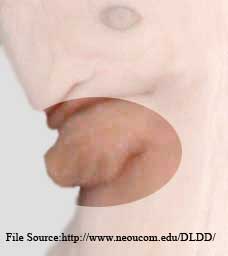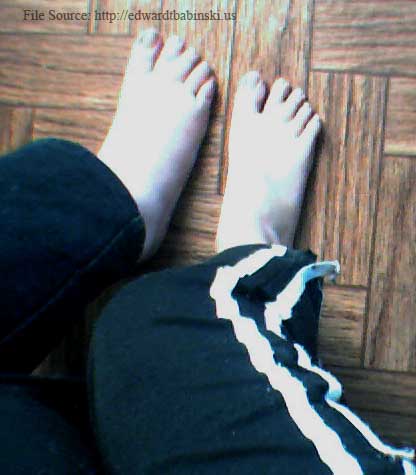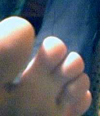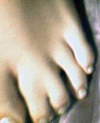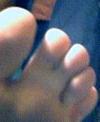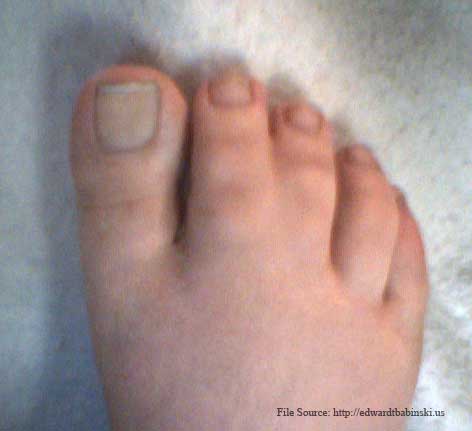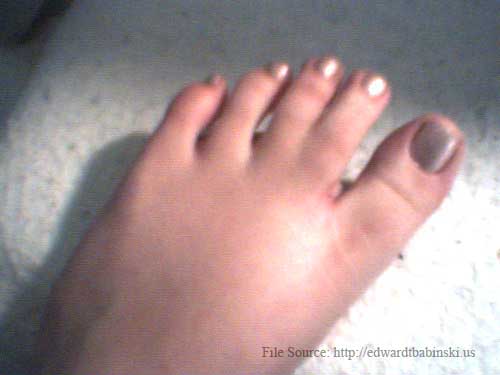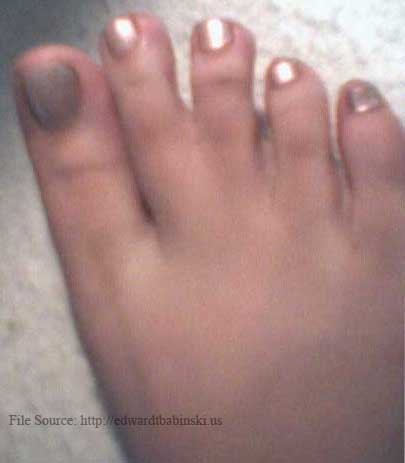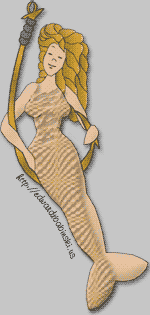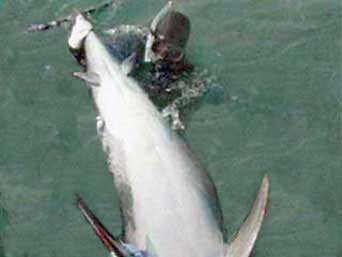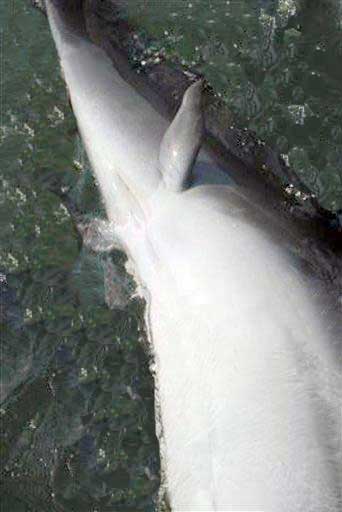Evolutionary Atavisms
by Kenneth Nahigian
(Adapted from writings by Ed Babinski)
We've all heard of human babies born with tails, which doctors routinely remove. Often the tail is merely a fatty appendage or growth, a glitch in development of the spinal column, like a sixth finger or cleft palate. But sometimes it manifests a complex system of blood vessels, nerves, vertebrae, ligaments and muscle, and can even move! Medical literature has over 100 well-documented reports-the longest known belonged to a boy in French Indochina, with a tail of nine inches.
These are genuine atavisms, or "throwbacks." They stand as strong evidence that the human genetic code still contains within it the complex instructions to form a primate tail.
Bernhard Herrmann of the Max Planck Institute for Molecular Genetics in Berlin, Germany, studied the development of the vertebral column. He said: "This is quite clearly an atavism. The ability to make tails is a feature of all vertebrates."
Ancestory within all creatures, newscientist.com
An interesting sidelight is that the coccyx, or "tail bone," has similar form in great apes and human beings. This tiny column of fused vertebrae (consisting of three to five bones) is all that remains of the tail that most monkeys (and other mammals, reptiles and amphibians) still use for balance and communication. In humans and the tailless great apes, the coccyx seems to be entirely vestigial-"surgically removing it has no discernible effect on health."
Human Tails, Discover Magazine
In fact, embryos of both humans and tailless apes show small tail-like protrusions just like those seen in embryos of tailed monkeys. In the apes and humans these protrusions shrink and become the coccyx (except for those rare atavisms); in monkeys, they become tails.
Some apes do have tails, incidentally. Even when human tails contain no vertebrae, doctors often observe blood vessels, muscles and nerve tissue of the same consistency as in the short-tailed Barbary ape.
Other human atavisms occur, many in fact. For a review, along with an x-ray image of a genuine human tail with numerous normal vertebrae in a row and detailed muscle structure, see: Atavisms, talkorigins.org
Atavisms also occur in other species, such as whales. You can see photos of modern whale embryos that show hind limb buds. The embryo usually reabsorbs these, but sometimes the buds grow into hind limb remnants with bones. One species of whale, the Right Whale, still has a pelvis, femurs and tibiae inside its blubbery body, joints between those cartilaginous bones, and muscles to move them a little.
See: Bejder and Hall
In the embryonic stages, snakes exhibit atavisms such as hind limb buds and a pelvis, which later shrink or vanish. See photo of hind limb buds and pelvis in snake embryo (compared with chicken embryo):
Hind Limb Buds in Snakes
Experiments in the 1970s or 80s also demonstrated that modern birds retain the genes to produce reptilian teeth. The earliest known fossil birds indeed had teeth, a long boney tail and a thick skull that was reptilian in shape, unlike the smooth helmet skulls of modern birds, but flatter and at diagonal angles. The earliest known birds were heavy, had long boney tails that dragged in the wind, and they had very small keel bones to which the flight muscles were attached. But modern flying birds have deep keel bones that stretch the entire length of their torso, as an anchor for enormous wing muscles. Clearly the earliest birds were not streamlined for efficient flight, not compared to later species of flying birds.
Impressed by this mountain of evidence, New Scientist magazine biomedical news editor Michael Le Page did a fascinating write-up titled "The Ancestor Within" (see the Jan. 13-19, 2007, issue). He observed that such atavisms can occur only because the genetic blueprints for certain traits never left the genome. These simply were "switched off," and in rare cases are switched back on. A throwback is possible only if there's something to "throw back to." Much as if someone builds a house with a similar floor plan to yours, including complex architectural glitches, flaws and eccentricities-you know a common blueprint must exist somewhere! "Atavisms like tails on humans are the exceptions that prove the evolutionary rule," wrote Le Page.
The occurrence of atavisms (human tails, pelvises and hind leg buds in snake embryos, hind leg buds still seen in whale and dolphin embryos, and the rest) is interesting-but even more so is the way they match up with patterns of genetic data, which in turn corroborate findings of paleontology (the order of appearance of fossils in geologic strata), which also back up patterns of anatomical similarity and vestiges. It is a classic case of many lines of independent evidence coming together, "clicking" like dovetailed joints. Scientists call it consiliance.
For a look at those genetic similarities, see this Scientific American article, "The Real Life of Pseudogenes," about disabled genes, molecular relics scattered across the human genomic landscape, which tell a story of common ancestry.
All the interlocking evidence, genetic and anatomical, is pretty breathtaking. It doesn't absolutely disprove a Designer, of course. What does it prove? Simply that the putitive Designer acts throughout nature exactly as neo-Darwinism would act! That is to say, in each and every case, in each and every species, the Designer acts opportunistically, simply using the genes and body-structures at hand. He never retools, never rebuilds from scratch, never goes back to the drawing board; he just modifies and adapts old structures. And in the process, he does not bother to clean up the old genetic data, but sloppily buries it, leaving clear clues to the line of descent, even shared errors, shared minor inversions, shared chromosomal numbers-even evidence of centromeres and inverted telomeres in human chromosome #2 that show how it arose via genetic fusion (a very sloppy one) of two chromosomes of some common ancestor of man and chimp.
In other words, the Designer is a slacker or a buffoon, working through trial and error, blindly cobbling together old parts to make new-exactly as evolution would work!
Interesting, don't you think?
Dr. Kenneth Miller is a professor of biology, textbook writer, evolutionist, and a passionate Christian. He spoke on the evidence that leads biologists to conclude that human chromosome #2 is the result of a fusion of two separate chromosomes found in humanity's closest living relatives. He explained the evidence during the Dover court case over whether or not schools ought to teach "Intelligent Design" in biology classes. Below are his words:
Evolution makes a testable prediction, and that is, somewhere in the human genome we've got to be able to find a human chromosome that actually shows the point at which two of these common ancestors were pasted together. We ought to be able to find a piece of Scotch tape holding together two chromosomes so that our 24 pairs -- one of them was pasted together to form just 23. And if we can't find that, then the hypothesis of common ancestry is wrong and evolution is mistaken.
Go to the next slide. Now, the prediction is even better than that. And the reason for that is chromosomes themselves have little genetic markers in their middles and on their ends. They have DNA sequences, which I've highlighted in here, called telomeres that exist on the edges of the chromosomes.
Then they have special DNA sequences at the center called centromeres, which I've highlighted in red. Centromeres are really important because that's where the chromosomes are separated when a cell divides. If you don't have a centromere, you're in really big trouble.
Now, if one of our chromosomes, as evolution predicts, really was formed by the fusion of two chromosomes, what we should find is in that human chromosome, we should find those telomere sequences which belong at the ends, but we should find them in the middle. Sort of like the seam at which you've glued two things together, it should still be there.
And we should also find that there are two centromeres, one of which has, perhaps, been inactivated in order to make it convenient to separate this when a cell divides. That's a prediction. And if we can't find it in our genome, then evolution is in trouble.
Next slide. Well, lo and behold, the answer is in Chromosome Number 2.
SOURCE: Dover, talkorigins.org
As another example, Dr. Steve Schaffner, statistical geneticist at the Whitehead/MIT Center for Genome Research, had these remarks about the "creationist or I.D.ist model":
Where is the creationist or I.D.ist model that explains the following types of observed genetic data? Such a model should produce estimates of the following measurable genetic data for modern humans:
- The minor allele frequency spectrum.
- The relationship between minor allele frequency and probability that the minor allele is the same as the chimpanzee base at that site.
- The ratio of transition (purine<->purine or pyrimidine<->pyrimidine) polymorphisms to transversion (purine<->pyrimidine) polymmorphisms.
- The ratio of polymorphisms at CpG sites to the overall polymorphism rate.
- The distance over which significant linkage disequilibrium extends in a chromosome.
- The genetic distance (difference in allele frequencies) between African and non-African populations.
- The difference between African and non-African populations in the extent of linkage disequilibrium.
- The distance over which significant autocorrelation in heterozygosity extends in a chromosome.
- The ratio of fixed transition to transversion differences between humans and chimpanzees.
- Same as (9), but for CpG sites.
There are other possible questions, but these are a reasonable starting point, since the quantities in question are all ones that I routinely use evolution to predict or interpret. If the claim is true that creationists/I.D.ists look at the same data and just interpret it differently, there should be no difficulty in providing the creationist interpretation of these data. (Note that the answers should be derivable by anyone using the same model.)
I'm happy to answer questions about my list (which is deliberately terse -- I didn't feel like writing a survey of population genetics). Young-earth creationists should have the most trouble meeting my challenge. As you allow more and more time, and more and more evolution, it becomes harder to distinguish special creation from evolution. In the extreme case where all God does is cause a small number of critical mutations in the development of humans, the results will look exactly like evolution (provided the mutations occur in a fairly large population). In that case, of course, you have to wonder why those mutations also couldn't have happened on their own, since every other mutation can.
Dr. Joel W. Cannon, of the Washington and Jefferson College Physics Department, is yet another example. Writing on a Christian email forum run by the American Scientific Affiliation, he said this about how genomes of different species provide evidence for evolution:
The information below was striking enough to me to take the time to pass it on. The biologists on the list will be able to provide more details or correct misstatements.
I am attending a workshop on quantitative approaches to gene regulatory systems. A couple of days ago, I was listening to a talk on the evolution of gene regulation. To study this, several research groups looked at 4 closely related yeast species which had diverged relatively recently (~ 20 million years is my recollection). They looked, among other things at the regulatory structures and the DNA region surrounding orthologs (a gene found in different species which has a common origin) and paralogs (two genes in a single species which has a common origin). More accurately, they used surrounding regions to help to discern orthologs and paralogs. The study found significant regions (I believe about 8\%) of ``ancient duplication blocks.'' There was a one to one mapping of genome regions among the 4 close species (for each region in on species there was a corresponding region of the genome in the close species).
Based on the patterns of similarity, an evolutionary biologist (K. H. Wolfe) argued that in an ancestor of the 4 species a whole set of genes had been duplicated (WGD or whole genome duplication) followed by rapid evolution and disappearance of one member of each pair. The claim was controversial. A number of others argued that there had been multiple small duplication events.
The problem was resolved in stunning fashion when two separate groups (my notes only record one group's name) sequenced other yeast species that descended from common ancestors that existed prior to the proposed WGD. Google on ``WGD Eric Lander'' to find the 2004 Nature paper by Kellis, Lander, and others to see the results of one of the groups. In contrast to the 1 to 1 mapping of the closely related species, the researches found that for every region in the species which is not a descendent of the WGD (K. Waltii), there are two corresponding regions in the WGD descendent (the common S. Cerevisiae). A total of 253 blocks of ``doubly conserved synteny'' containing 75\% of the K. Waltii and 81\% of the S. Cerevisiae genomes were identified. If you get the paper at the website, there is a stunning graphical depiction of the mapping.
Another thing the authors of the paper did was to look at the subsequent divergence of the paired genes. One biologist had predicted that in WGD, one set of genes would preserve the original function and the other would diverge (naturally, someone else argued the converse---that divergence would occur in both sets -- i.e. all genes). Based on the analysis, the first appears to have happened. The authors found that 17\% of the genes underwent accelerated evolution, defined to by amino acid substitution in the duplicated genome at least 50\% faster than the genes in K. Waltii. 95\% of these cases occurred in only one of the gene paralogues (i.e. one of the pair was stable, one was not). Thus it appears that one paralog retained the ancestral function, the other was free to evolve more rapidly.
One other interesting point is that the duplicated descendents' metabolism shifted from aerobic respiration to anaerobic respiration (fermentation). Thus the alcohol my conservative friends will not consume originated in the evolutionary process whose reality they deny.
Here are references for evidence of genome duplication between species, as discussed in dr. cannon's post above:
" Kenneth H. Wolfe & Denis C. Shields, Molecular Evidence for an ancient duplication of the entire yeast genome, Nature, 387, p. 709, 12 June 1997.
Papers analyzing connections between S. cerevisiae and species from pre-WGD branch:
" M. Kellis, et. al., Proof and Evolutionary analysis of ancient gene duplication in the yeast Saccharomyces cerevisiae, Nature, 428, 617-24, 2004.
" F. Dietrich, et. al., The Ashbya gossypii genome as a tool for mapping the ancient Saccharamoyces cerevisiae genome, Science, 304, 304-307, April 9, 2004.
More on whole genome duplications in nature, along with evidence of subsequent "whittling down" and mutating of the duplicated genetic material:
" "Unmistakable" evidence for "whole genome duplication" in the vertebrate line of evolutionary changes has been found: Two rounds of whole genome duplication in the ancestral vertebrate. PLoS Biol. 2005 Oct;3(10):e314. Epub 2005 Sep 6. Related Articles, Links.
Abstract: ... unmistakable evidence of two distinct genome duplication events early in vertebrate evolution indicated by clear patterns of four-way paralogous regions covering a large part of the human genome. Our results highlight the potential for these large-scale genomic events to have driven the evolutionary success of the vertebrate lineage.
(Paralogous Genes are "two genes or clusters of genes at different chromosomal locations in the same organism that have structural similarities indicating that they derived from a common ancestral gene and have since diverged from the parent copy by mutation and selection or drift.")
" Genome duplication in the teleost fish Tetraodon nigroviridis reveals the early vertebrate proto-karyotype. Nature. 2004 Oct 21;431(7011):916-7.
Abstract: ... analysis of the tetradon and human genomes shows that whole-genome duplication occurred in the teleost fish lineage, subsequent to its divergence from mammals. The analysis also makes it possible to infer the basic structure of the ancestral bony vertebrate genome …"
" GENE DUPLICATIONS AND VERTEBRATE PHYLOGENY by James Cotton (circa 2001):
Excerpt: "Theoretical studies have shown that gene duplications may be relatively likely to lead to new gene functions, and to increase the fitness of genomes in which they occur. Walsh (1995) presents a population genetic model suggesting that, for large populations, 'new gene function, rather than pseudogene formation, is the expected fate of most duplicated genes', which would make gene duplication an impressively powerful mechanism for the evolution of novel biochemistry and novel developmental processes. Specifically, new functions are likely to evolve where rS >> 1, where S = 4Nes and Ne is the effective population size, S is the selection coefficient and r is the ratio of advantageous to other mutations. This model is likely to underestimate the rate of evolution of new gene functions, principally because it assumes that all nonadvantageous mutations are neutral, where in reality many will be more or less deleterious. Ohta (1989) admits that 'gene duplication could well have been the primary mechanism for the evolution of complexity in higher organisms', and presents models for the origin of 'gene families with diverse functions', concluding that natural selection should favour those genomes with more favourable mutations occurring in duplicated genes, so there should be selective pressure favouring mechanisms of gene duplication. Ohta has also presented a number of other simulation studies on the evolution of large gene families (Batson and Ohta, 1992; Ohta 1987, 1988a, 1988b), which broadly support the likelihood of this model in molecular evolution. Empirical studies (such as Nadeau and Sankoff, 1997) largely suggest that the evolution of new functions is even more common than theoretical studies suggest, but there are a number of difficulties with the empirical work (Wagner, 1998)."
Another Excerpt: "The very existence of families of paralogous genes also provides powerful evidence for the importance of gene duplications, so data like those shown in figure 2 seem to confirm that gene duplications have indeed played a very powerful role in shaping genomes. Although, as discussed later, much interest has focused on gene duplications in vertebrates, there is substantial evidence (e.g. Brenner et al., 1995; Wolfe and Shields, 1997) that gene duplications have also been important in other organisms, such as in the evolution of cell-to-cell communication pathways in the first multicellular animals (Suga et al., 1999. Ono et al, 1999). It is also important to note here that a number of potential mechanisms for gene duplication have been suggested, ranging from unequal crossing-over, which will lead to duplication of a relatively small stretch of DNA, to polyploidisation, which will lead to duplication of the entire genome."
If you fear that accepting evolution will compel you to give up Christianity, remember that many professional biologists are both Christians and evolutionists, including Francis Collins, head of the human genome project. Keep reading all sides; what you learn will surprise you. Also check the links and names and books in Christian Evolutionist Resources.
Please read this article, a good sum-up of the evidence for macroevolution.
It seems significant that the fossil history for humans is so smooth and continuous, young earth creationists cannot agree whether some fossil hominids are apes are humans.
Creationists Admit "Difficulties" With Their Hypothesis.
Also read about two former young-earth creationists (YECs), Glenn Morton and Kevin R. Henke, both of which have advanced degrees in geology:
Glenn Morton, "Why I Left Young-Earth Creationism".
Other articles by Glenn and Kevin, among others.
Answers in Genesis' Response on Evidence for Whale Evolution Dr. Sarfati's response to a simple request to examine the evidence of hind limb rudiments on modern day whales.
Back to Main Index
Cetacean Evolution (Whales, Porpoises, Dolphins)


